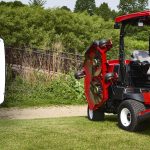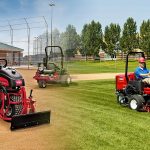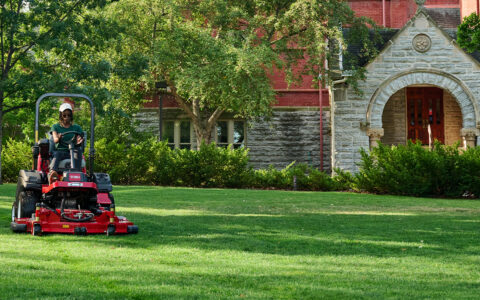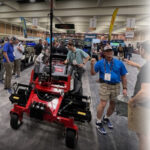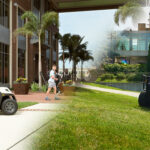The True Cost of Owning a Commercial Mower
For the turf industry, mowing equipment has evolved as regulations and innovation continue to change the paradigm. Grounds professionals seek out new ways to control budgets, while still delivering high-quality results. While equipment acquisition costs continue to rise, many professionals understand that the “purchase price” is not all that needs to be considered. Too often during the purchasing process, decisions are made solely on the lowest price with little attention paid to long-term costs of labor, maintenance/service, downtime, fuel, and other factors that will influence future budgets.
The lifetime cost overview chart shown below, which is based on a 6,000 hour operating life expectancy for a piece of mowing equipment, illustrates that up to 90% of the total cost of ownership can reside in labor, maintenance/service, downtime and fuel.
A more in-depth analysis of each of these key areas will show how improvements in efficiencies in any of these areas can result in an improved total cost of ownership. Moreover, purchase decisions based on a more holistic view of lifetime costs are essential if you want to get the most value and optimum ROI from your equipment purchases.

Productivity
The productivity of mowing equipment is measured as the rate at which work is performed, usually expressed in acres per hour. Key variables such as operating speed and the width of the cutting path impact productivity. As speed increases, however, it can also have an adverse effect on the quality of cut. Additionally, items such as overlaps, stops, turns, trimming, and maneuvering around obstacles take time and decrease the overall efficiency of a piece of equipment.
The more productive the equipment, the better grounds professionals can manage labor costs per acre. Here are some productivity related features to consider when evaluating a piece of equipment:
- Adequate engine power to cut heavy grasses at higher ground speeds
- Trimming capabilities – e.g. the ability to mow a 0” uncut circle
- Proper cooling fans to help reduce engine overheating and fatigue
- Traction unit “turf friendliness” to reduce turf damage from tires/turns
- Cutting unit flotation or support rollers to ensure high ground speeds without scalping
- Proper traction controls and stability for side hill mowing to eliminate the need to care for areas with other products
- Ability to use individual wheel brakes or have four-wheel steering to improve trimming and facilitate slope operation
- Operator features that reduce fatigue and make them more productive – comfortable seats, integrated control hub or info center, cooling systems and ergonomic features
- Reinforced structure, shock-absorption, heavy duty spindles and bearings
Fuel
Additional consideration for operational costs, such as fuel consumption, should be made as well. Increased gas taxes, supply and demand challenges, and consumption have made fuel costs a moving target. Mowing equipment fuel consumption is determined by engine efficiency and engine horsepower.
The way equipment is designed will directly impact how efficient the machine operates, and consideration for how the cutting units are driven is important. Of the two types of mowers – rotary and reel – reel mowers require about half the horsepower of rotary mowers. Generally, hydraulically driven equipment consumes twice as much power as mechanical devices. A properly designed cutting unit, for example, saves fuel costs by using aerodynamics to help discharge grass clippings properly.
Today, more hybrid and electric technology designs are replacing the large traditional gas or diesel engine models. Many of these hybrid machines marry electrical components with smaller horsepower engines and may reduce fuel consumption from 15-20% while simultaneously reducing noise levels. Many hybrid machines use electric motors to operate the cutting units, reducing the need for hydraulic components, and increasing efficiency and the quality of cut. Hybrid mowers also incorporate technology that allows the operator to have a better understanding of how their equipment is performing.
Recently, some mowing equipment has become all-electric, reducing the direct fuel cost entirely. While this technology is primarily focused on reel mowers, it allows for innovation focused on how the machine directly impacts the quality of cut and turf.
Hybrid and all-electric machines tend to have a higher acquisition cost than traditional mowers, but they can often be the best value when considering the significant savings in a number of operational areas.

Maintenance/Service
Mowing equipment wear-and-tear is generally measured in hours of use. While engine hours may be easy for grounds professionals to understand, it can be difficult for many of those making purchase decisions to grasp. Since most people use miles on their automobiles as a reference, it can be helpful to create a meaningful correlation between the two. To that end, the USGA developed a simple analysis to convert machine hours to miles.
After six years, it would have an equivalent total of 293,760 miles on it. Non-turf professionals can quickly see how this level of wear-and-tear would impact your maintenance and service costs as well as play a role in how often the mower may need to be replaced.
There are two types of maintenance and service. One is predictive and focuses on routine maintenance the manufacturer recommends for the piece of equipment. The other is reactive and is generally one of those “bad surprises” that can arise if a mower is not maintained properly, or due to an operator error. Both of these have a major impact on the operational cost of owning a mower.
Staying on top of routine maintenance and service, which can be a large expense, is imperative. If equipment is not properly designed for the intended use, maintenance costs can quickly escalate.
Key factors to consider include:
- Cost and availability of parts
- Labor costs
- Downtime
The annual cost of maintenance and service can quickly escalate to be more than the acquisition price of the equipment if it is not properly maintained, so sound maintenance and servicing practices save money. Proper record keeping can also help a grounds professional decide when it’s time to look at replacement and can be an advantage when trading in the unit.
Downtime
All equipment has downtime. The key is to minimize the amount of time the equipment is out of service. For planned downtime, many operations redirect employees to perform other duties. But for an unplanned breakdown, the operation will incur costs not only associated with the machine repair (labor & parts), but also:
- Downtime cost of that employee
- Possible overtime to still get the job done
- Potentially negative impact on customer expectations
- Additional unplanned usage on other equipment to try and supplement
- Additional cost of backup equipment
- Additional cost for expedited shipment of needed parts
Downtime should be discussed between the grounds professional and management team so that everyone understands its true cost.

Labor
The cost of labor is by far the largest contributing factor when looking at cost of ownership. Finding ways to increase efficiency here can have a large impact on your budget. In terms of mowing, labor utilization is primarily the amount of time an employee spends mowing, but there are other costs associated with labor. For example, loading and unloading, paid breaks, transportation, cleaning, and fueling equipment all reduce the effective time mowing, thus reducing labor utilization.
In recent years, it has also become increasingly difficult for most employers to find qualified operators. This can lead to higher wages for experienced operators, as well as increases in reactive maintenance costs or potential damage to facilities when inexperienced operators use a machine. Factors to consider when looking at labor costs include:
- Hourly rate
- Employee FICA contributions
- State and federal taxes
- Any pension or profit-sharing contributions
- Workmen’s compensation costs
- Vacation or sick pay
- Medical, dental or life insurance contributions
- Educational or training allowances
Purchasing
First, make sure you are looking at the right mower for the results you want. Today’s mowers come in many configurations. Work with your supplier(s) to make sure you are comparing units with the same configuration to meet your mowing needs. If you require a demonstration, be sure to provide setup requirements including desired height of cut and machine configuration, then test the units being considered under the same conditions.
High quality service and support from your local equipment supplier can also influence your decision, and can potentially reduce operational and downtime costs, so ask these questions:
Questions for the Local Supplier
- What are your service capabilities?
- How many certified technicians?
- Is mobile service available?
- What parts do you stock?
- Do you ship parts?
- Do you rent similar equipment?
Questions for Supplier References
- How quick was a service response?
- Is the service shop professional and clean?
- How long was the wait for parts?
- How was the purchase process?
- How is/are your machine(s) operating?
- What type of training did they offer?
It is also wise to consider the ownership costs associated with the acquisition, which generally include: 1) Depreciation, 2) Investment Alternatives, and 3) Taxes.
Unlike operational costs that can escalate, ownership costs tend to be more fixed. Larger mowers or those designed with more expensive components may have a higher ownership cost but lower per-acre operating costs. The rate at which the higher ownership costs are paid back depends on the amount of operating savings and the degree to which the equipment is utilized versus alternative options.
The Big Picture
When we look at the bigger picture and take a more holistic approach to lifetime cost of ownership, it becomes clear that the lowest purchase price for mowing equipment is not always the cheapest or best option in the long-run. By understanding the true costs of ownership, as outlined in this article, you can make a well-informed mowing equipment purchase decision.


